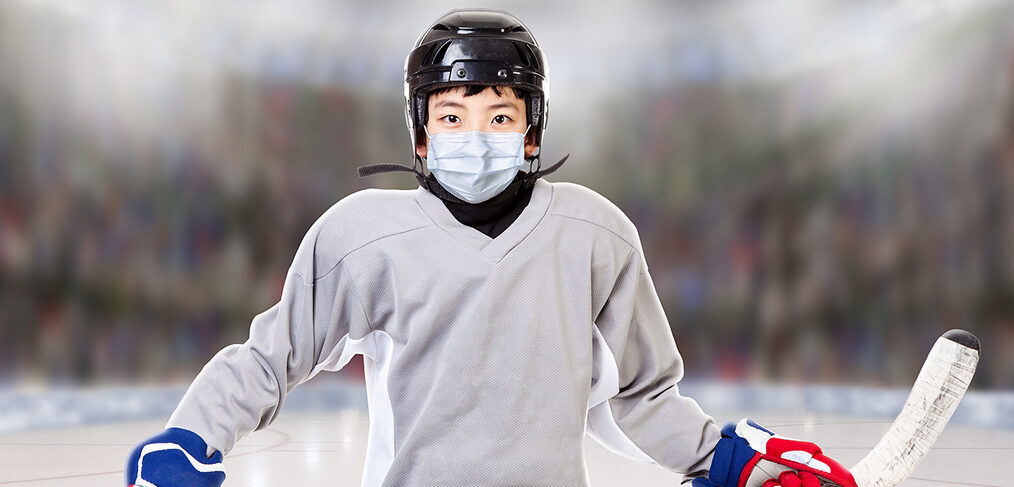
Face mask use among athletes while exercising has no significant effect on physiologic parameters
CHICAGO (March 22, 2022)—Millions of athletes worldwide have been wrestling with the challenges of working out under stay-at-home orders and evolving COVID-19 mandates and concerned about wearing a face mask if training in public or outside. To date, there has been no systematic review of existing literature that provides a clear consensus on whether wearing a face mask significantly impacts exercise performance, particularly with respect to physiologic parameters including heart rate, respiratory rate, oxygen saturation, and perceived exertion. A new study presented at the 2022 Annual Meeting of the American Academy of Orthopaedic Surgeons (AAOS) found that despite commonly cited concerns regarding safety and performance decrements when wearing masks, healthy individuals can perform heavy exercise wearing masks with minimal physiologic changes.
“As mask mandates took effect during the COVID-19 pandemic, our patients and the general population wanted to know how masks impacted performance outcomes since, theoretically, anything that covers the mouth and/or nose could increase the resistive work of breathing,” said Cordelia W. Carter, MD, FAAOS, pediatric orthopaedic sports surgeon and director of the Center for Young Athletes at NYU Langone’s Hassenfeld Children’s Hospital in New York.
With limited scientific-based information to provide guidance, Dr. Carter approached Ariana Lott, MD, an orthopaedic surgery resident at NYU Langone Health, to help her uncover evidence that could provide data-driven guidance on the impact of mask wearing on athletic performance.
Drs. Carter and Lott followed the Preferred Reporting Items for Systematic Reviews and Meta-Analyses (PRISMA) guidelines to search for available studies on mask use during exercise in their study, “Mask Use for Athletes, A Systematic Review of Safety and Performance Outcomes.” They sought to identify studies that described the effects of oronasal mask use (covers the nose and mouth), if any, on sports/exercise/physical activity for any age, gender, or level of sport. Articles that described mask use to improve athletic performance were also included. Articles describing mask effects without exercise, those that measured effects of full-face masks, review articles, and those published prior to 1980 were excluded. Additionally, non-English studies were excluded during full-text review.
Of the all the records that were identified for possible inclusion, 22 articles met the inclusion criteria. These articles studied a variety of populations, including healthy adult volunteers, high-level athletes, children, pregnant women, and patients with pulmonary comorbidities including asthma and chronic obstructive pulmonary disease (COPD). The team analyzed these articles and extracted data focused on physiologic parameters measured during physical activity performed while wearing an oronasal face mask.
Analysis revealed that healthy individuals can perform moderate-to-vigorous exercise while wearing a face mask without experiencing changes in heart rate, respiratory rate, and oxygen saturation that would compromise individual safety or athletic performance. Of the studies that investigated N95 respirators in the healthy adult population, two reported modest changes in respiratory rate (up 10 breathes per minute at maximum exercise)1 and maximum power output indicative of decreased athletic performance when subjects were exercising at maximum effort. Similar findings related to N95 respirator use were seen in studies of subpopulations including children and pregnant women.
Interestingly, it was noted that female children had higher maximal output during exercise when they were wearing a mask,2 and there was no difference in fetal heart rate for pregnant subjects exercising while wearing a mask.3
“As current mask mandates are eased, there are still vulnerable populations who prefer to wear a mask during exercise to protect themselves or others from illness,” said Dr. Lott. “Given the myriad benefits of exercise and participation in sports, it was important for us to create a comprehensive review of the existing literature to ensure athletes could still exercise safely with a mask. While most studies we analyzed were not conducted during the COVID-19 pandemic, we anticipate more literature to be published in the coming years that could evolve our research.”
# # #
2022 AAOS Annual Meeting Disclosure Statement
About the AAOS
With more than 39,000 members, the American Academy of Orthopaedic Surgeons is the world’s largest medical association of musculoskeletal specialists. The AAOS is the trusted leader in advancing musculoskeletal health. It provides the highest quality, most comprehensive education to help orthopaedic surgeons and allied health professionals at every career level to best treat patients in their daily practices. The AAOS is the source for information on bone and joint conditions, treatments, and related musculoskeletal health care issues, and it leads the health care discussion on advancing quality.
Follow the AAOS on Facebook, Twitter, LinkedIn, and Instagram.
For more information, contact:
| Deanna Killackey | 847-384-4035 | 630-815-5195 | killackey@aaos.org |
| Lauren P. Riley | 847-384-4031 | 708-227-1773 | pearson@aaos.org |
Sources:
- Jones JG. The physiological cost of wearing a disposable respirator. Am Ind Hyg Assoc J. 1991 Jun;52(6):219-25.
- Tompuri TT, Lintu N, Soininen S. Comparison between parameters from maximal cycle ergometer test first without respiratory gas analysis and thereafter with respiratory gas analysis among healthy prepubertal children. Appl Physiol Nutr Metab. 2016 Jun;41(6):624-30.
- Roberge RJ, Kim JH, Powell JB. N95 respirator use during advanced pregnancy. Am J Infect Control. 2014 Oct;42(10):1097-100.
